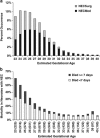Characteristics of patients who die of necrotizing enterocolitis
- PMID: 21593813
- PMCID: PMC3289772
- DOI: 10.1038/jp.2011.65
Characteristics of patients who die of necrotizing enterocolitis
Abstract
Objective: Necrotizing enterocolitis (NEC) is associated with high morbidity and mortality among infants admitted for intensive care. The factors associated with mortality and catastrophic presentation remain poorly understood. Our objective was to describe the factors associated with mortality in infants with NEC and to quantify the degree to which catastrophic presentation contributes to mortality in infants with NEC. Catastrophic NEC was defined before data analysis as NEC that led to death within 7 days of diagnosis.
Study design: We performed a retrospective review of the Pediatrix's Clinical Data Warehouse (1997 to 2009, n=560,227) to compare the demographic, therapeutic and outcome characteristics of infants who survived NEC vs those who died. Associations were tested by bivariate and multivariate analysis.
Result: We compared the 5594 infants diagnosed with NEC and who were discharged home with 1505 infants diagnosed with NEC who died. In multivariate analysis, the factors associated with death (P<0.01 in analysis) were lower estimated gestational age, lower birth weight, treatment with assisted ventilation on the day of diagnosis of NEC, treatment with vasopressors at the time of diagnosis, and Black race. Patients who received only ampicillin and gentamicin on the day of diagnosis were less likely to die. Two-thirds of NEC deaths occurred quickly (<7 days from diagnosis), with a median time of death of one day from time of diagnosis. Infants who died within 7 days of diagnosis had a higher birth weight, more often were on vasopressors and high frequency ventilation at the time of diagnosis compared with patients who died at 7 or more days. Although mortality decreased with increasing gestational age, the proportion of deaths that occurred within 7 days was relatively consistent (65 to 75% of the patients who died) across all gestational ages.
Conclusion: Mortality among infants who have NEC remains high and infants who die of NEC commonly (66%) die quickly. Most of the factors associated with mortality are related to immaturity, low birth weight and severity of illness.
Figures

References
-
- Christensen RD, Gordon PV, Besner GE. Can we cut the incidence of necrotizing enterocolitis in half--today. Fetal Pediatr Pathol. 2010;29 (4:185–198. - PubMed
-
- Henry MC, Lawrence MR. Surgical therapy for necrotizing enterocolitis: bringing evidence to the bedside. Semin Pediatr Surg. 2005;14 (3:181–190. - PubMed
-
- Lin PW, Nasr TR, Stoll BJ. Necrotizing enterocolitis: recent scientific advances in pathophysiology and prevention. Semin Perinatol. 2008;32 (2:70–82. - PubMed
-
- Lin PW, Stoll BJ. Necrotising enterocolitis. Lancet. 2006;368 (9543:1271–1283. - PubMed
Publication types
MeSH terms
Grants and funding
LinkOut - more resources
Full Text Sources
Other Literature Sources

